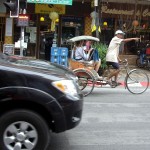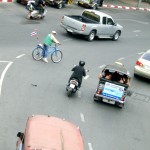“The experience of being unexpected yourself might make you better able to notice similar unexpected events.” ~ The Invisible Gorilla by Christopher Chabris and Daniel Simons.
 I can’t count how many times I have been chatting with a foreigner in Thailand and, when they find out my primary mode of transportation is my bicycle, they express surprise that I feel safe traversing the traffic in what often seems to them like an unorganized mess. They are also usually surprised when I tell them that I feel far safer cycling in Thailand than I do in most US cities, especially my hometown in Central Illinois.
I can’t count how many times I have been chatting with a foreigner in Thailand and, when they find out my primary mode of transportation is my bicycle, they express surprise that I feel safe traversing the traffic in what often seems to them like an unorganized mess. They are also usually surprised when I tell them that I feel far safer cycling in Thailand than I do in most US cities, especially my hometown in Central Illinois.
According to a study done by Christopher Chabris and Daniel Simons in the book The Invisible Gorilla, our expectations have great power over what we notice and, conversely, what we don’t notice. They formed this conclusion after a test where participants were asked to watch a video of a basketball game and count the number of passes between members of a certain team. During the video, a person in a full gorilla costume came onto the court, pounded his chest and walked back off the court. More than half the people watching the video did not see the gorilla.
This idea of expectation goes a long way towards explaining why I feel safer cycling on Thai roads than I do in the US. If you look around at the traffic in Thailand you will notice that there are a lot of slow moving vehicles: from motorcycles modified with sidecars full of produce to rickshaws with passengers pulled by bicycle. So, while the traffic might appear more reckless, the drivers are actually expecting slow moving vehicles, which means, cyclists are not Invisible Gorillas in Thailand.
Thai drivers being more likely to see and expect slow moving vehicles should give you more confidence while cycling on the roads of Thailand. There are also a couple of other expectations of Thai drivers that can help you avoid being an Invisible Gorilla.
First, Thai traffic is like flowing water: if there is room on the road, even if it is obvious that the extra lane of traffic that is open now will be blocked in 100 yards by a car parked in that lane, you are expected to fill the open space. In that 100 yards, the cars and motorbikes that have been following behind you will probably take their opportunity to pass you.
 Second, you are expected to be responsible for what you can see in front of you, up to the edge of your peripheral vision. This means that if you are passing a car, you are responsible to avoid that car up until that driver can, probably, see you in their peripheral vision. And, if the car is passing you, they are responsible not to hit you until they can’t see you in their peripheral vision any more. As you might imagine, this creates a discrepancy, as a car is quite a bit larger than a bicycle, and they no longer consider you their responsibility if they can’t see you without turning their heads or using their mirrors. Being aware of this expectation can help you remain prepared to apply your brakes, especially if the car is passing you near an intersection.
Second, you are expected to be responsible for what you can see in front of you, up to the edge of your peripheral vision. This means that if you are passing a car, you are responsible to avoid that car up until that driver can, probably, see you in their peripheral vision. And, if the car is passing you, they are responsible not to hit you until they can’t see you in their peripheral vision any more. As you might imagine, this creates a discrepancy, as a car is quite a bit larger than a bicycle, and they no longer consider you their responsibility if they can’t see you without turning their heads or using their mirrors. Being aware of this expectation can help you remain prepared to apply your brakes, especially if the car is passing you near an intersection.
As the smaller vehicle in the situation of cycling on the road, I always recommend looking for traffic before you change lanes, and letting the drivers know where you are turning whenever possible. Communication is never a bad thing! However, knowing that the other drivers on the road have these expectations of you can help you avoid being an Invisible Gorilla, and enjoy your cycling in Thailand that much more.
[SHARE]
Leave a Reply